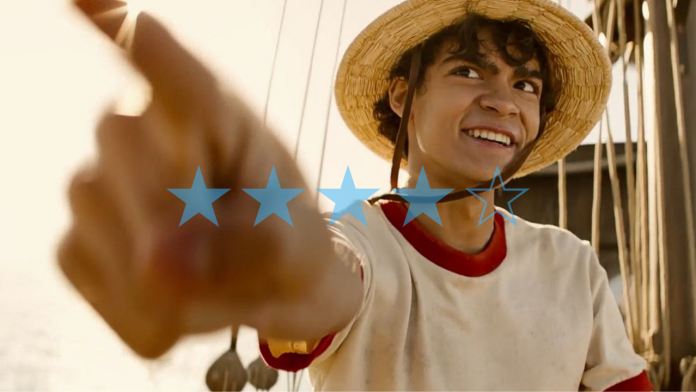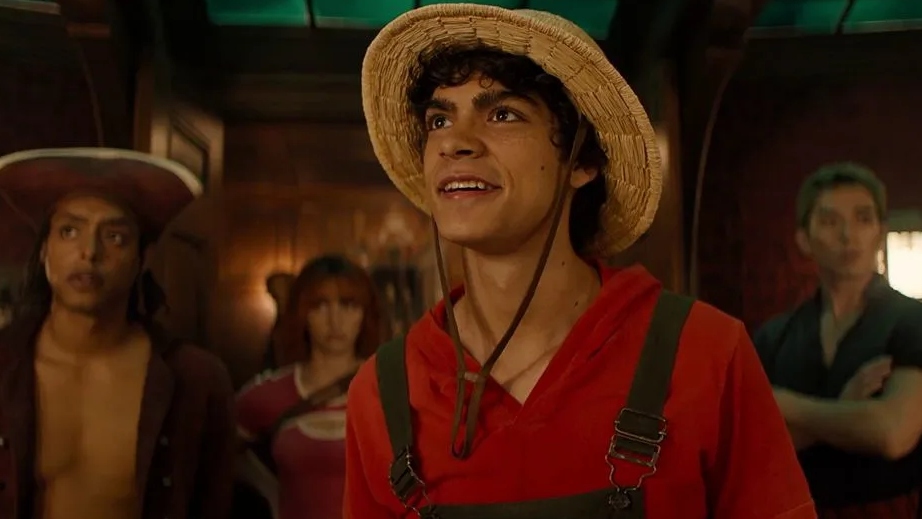Embarking on a swashbuckling adventure, Netflix delves into the turbulent waters of Eiichiro Oda’s beloved manga with their live-action rendition of ‘One Piece.’ A journey filled with political undertones, fantastical creatures, and a boundless spirit, Netflix’s Shonen anime adaptation surprisingly emerges as one of the most captivating in recent memory.
★★★★✰
Set in a fantastical universe teeming with pirates, monsters, and fish-men, One Piece defies the laws of physics, with characters sporting hair as vibrant as sea moss, incredible superpowers, and friendship taking precedence over romance. In this sprawling narrative, the world is engulfed by the ocean, and the challenge of adapting such an expansive and unique setting looms large. Yet, Netflix’s most ambitious endeavour rises to the occasion and has proven that it’s possible to capture the essence of this beloved saga.
One Piece currently boasts over a thousand episodes in its anime adaptation, and the live-action rendition seamlessly captures the exuberance of its source material. The story kicks off with the capture and impending execution of the infamous pirate Gold Roger by the World Government and their Marines. His final words inspire pirates across the world, including the free-spirited Monkey D. Luffy (energetically portrayed by Iñaki Godoy), to embark on a quest to become the Pirate King and claim the fabled One Piece treasure. But Luffy’s aspirations extend beyond personal wealth; he seeks to liberate those oppressed by the World Government and build a crew that functions as a tight-knit family. His power, gained from eating a rare and mysterious Devil Fruit, grants him elasticity and superhuman abilities, transforming him into a Looney Toons-esque character thrust into a gritty world of flesh, blood, and gravity. Adapting such fantastical elements is no small feat.
The stars of the show are impressive, to say the least, with each member of Luffy’s crew perfectly cast. Emily Rudd embodies Nami, a thief with a deep understanding of the emotional toll of oppression, wielding a bo staff with precision and aspiring to map the world. Nami gets a lot more attention and focus than anyone, besides Luffy, giving a much heavier weight to the pain of her backstory. In contrast, Mackenyu brings a slippery coolness to Zoro, a character who casually wields a third sword in his mouth. Jacob Romero’s Usopp injects a bumbling charm into the group, while unfortunately having much of his best material and character development sidelined during his arc in Syrup Village in favour of the rest of the cast. He still gets a moment to prove himself during the assault on Arlong Park, equipped with his trusty slingshot and trick bombs. Taz Skylar, as Sanji, not only excels as the crew’s charming chef but also nails his kick-based combat, despite the questionable wig choice.
As for Iñaki Godoy’s portrayal of Luffy, it’s a nuanced tightrope act. Luffy stands as a unique character in a landscape dominated by white-colonial media — a man whose kindness and commitment to friendship are central to his identity. He’s a political insurgent wrapped in a goofy, grinning exterior, never devolving into a one-dimensional fool. His showdown with the fake butler Captain Kuro might have been drastically different from the manga, but Luffy’s “Gum-Gum Bell” headbutt is so ridiculously funny that it will leave fans with a smile as wide as the Grand Line.
While the core cast shines, some supporting characters could use more depth. Garp, in particular, needs a sharper edge, as the series fast-tracks Luffy’s journey and diminishes the urgency of their relationship. Garp’s reveal as Luffy’s grandfather and the return of Coby arrive much earlier than anticipated, catching fans off guard as the reveal would not happen in the manga for hundreds of chapters. Still, his formidable strength, demonstrated by his ability to hurl cannonballs with his bare hands, remains true to the original character. Peter Gadiot’s Shanks, a pivotal character in Luffy’s backstory, falls somewhat flat, lacking the depth of a character who effortlessly oscillates between jolly and imposing. Fortunately, the series devotes ample attention to its principal villain, Arlong, played convincingly by McKinley Belcher III. Arlong’s earlier introduction and significantly larger presence than the manga not only builds upon the depth of Nami’s backstory but also adds depth to the show’s world-building appealing to both dedicated fans and newcomers.
The show’s presentation of characters is a visual feast, from their costumes, makeup, and hair to the production design of their unique environments. A braided moustache or a splash of vibrant colour remixes the pirate aesthetic, while the distinct settings, such as the seafaring Baratie restaurant and Arlong Park, add richness to the visual narrative. The diverse colour palette, from wildflower orange to ocean cerulean to arterial-blood red, complements the characters and their environments with a unique aesthetic. However, these visuals are impressively overshadowed by moments of elasticity (or should that be rubbery?) and vibrancy, such as Zoro’s acrobatic feats or Sanji’s balletic combat style. The action sequences, while not reaching the vibrant and over-the-top heights of the anime, manage to infuse the show with humour, heart, and narrative audacity. Unlike Cowboy Bepop or Death Note, One Piece finally demonstrates that a successful anime adaptation isn’t as impossible as it may seem.
Notably, the show’s first season covers an impressive amount of ground. By the fourth episode, Luffy and his crew obtain their dream ship and leave Syrup Village, an event that occurs much later in the anime. Sanji’s mentor and chef of the Baratie, Zeff, even had the original cannibalistic story of how he lost his leg make it into the show, an origin that had been altered for the anime adaptation. Even the music pays tribute to the original One Piece anime intro theme “We are!” and pirate shanty “Bink’s Sake” in the show’s score.
Not everything made the cut, however, as many minor villains and side characters such as Mohji the Beast Tamer, the hypnotist Jango, or the octopus fish-man Hatchan (who plays a larger role in the Straw Hat Crew’s story much later in the manga) are unfortunately absent. That said, this streamlined approach works exceptionally well, delivering a fast-paced narrative that spans diverse ships, crews, and islands, each with its own cultures and creatures, a testament to Oda’s world-building and the great chemistry between the cast members.
The Verdict
As you embark on this live-action voyage, don’t be surprised if you find yourself eagerly awaiting the next chapter in the Straw Hat Pirates’ adventures. Whether Netflix’s One Piece will have the opportunity to adapt all 1,073 episodes of the anime remains uncertain. Still, given the achievements of the live-action series thus far, it’s clear that this remarkable journey is a treasure trove that’s far from over.
Words by Kieran Webb.
One Piece is available now to stream on Netflix.
Support The Indiependent
We’re trying to raise £200 a month to help cover our operational costs. This includes our ‘Writer of the Month’ awards, where we recognise the amazing work produced by our contributor team. If you’ve enjoyed reading our site, we’d really appreciate it if you could donate to The Indiependent. Whether you can give £1 or £10, you’d be making a huge difference to our small team.

